Helical Nanostructures of Ferroelectric Liquid Crystals as Fast Phase Retarders for Spectral Information Extraction Devices: A Comparison with the Nematic Liquid Crystal Phase Retarders
Abstract
1. Introduction and Motivation
2. Comparison of the Electrooptic Response of nh-FLCs with NLCs
3. Nematic versus DHF for Spectral Information Reconstruction
- Due to the spontaneous polarization and a very short helix pitch, DHFLC retarder has a shorter response time in the hundred or even tens of microseconds region while the response time of NLC is in the tens of milliseconds region. Moreover, increasing the retarder thickness in NLC causes an increase in the response time significantly, as Equation (4) shows, while the response time of DHFLC is thickness independent according to Equation (12).
- Thick NLC retarders provide a large phase retardation shift, which leads to many fringes in the spectral modulation at zero voltage. By increasing the applied voltage, the total retardation of NLC decreases and the number of fringes decreases, as can be seen in Figure 3. This is considered an essential requirement to extract hyperspectral data with a smaller number of measurements [41]. In the case of DHFLC retarders, the phase retardation change is smaller by factor of 2–3. As a result, the number of fringes remains high at high voltages as Figure 7 shows. Hence, a larger number of measurements is required to compensate for that. However, the DHFLC fast response time could restrain this limitation.
- NLC retarders are operated at lower voltages with respect to DHFLCs because the former responds to the voltage while the latter responds to the field.
- Due to the various possible alignment materials and process simplicity, fabricating stable thick NLC retarders is more achievable than DHFLC.
- DHFLCs exhibit larger field of view than NLCs because the optic axis remains in the plane of the substrates.
- Both the NLC and the DHF have no hysteresis effects because the DHF is driven at voltages lower than the threshold.
4. Design and Simulation Results
4.1. The Inverse Scattering Approach
4.2. System Simulation of Multi-Band Pass Filter
4.3. Simulations Outputs
4.3.1. Nematic Case
4.3.2. DHFLC Case
4.4. Viewing Angle Effect on Inverse Scattering Results
5. Conclusions
Author Contributions
Funding
Institutional Review Board Statement
Informed Consent Statement
Data Availability Statement
Conflicts of Interest
References
- Chen, H.; Lee, J.; Lin, B.; Chen, S.; Wu, S. Liquid crystal display and organic light-emitting diode display: Present status and future perspectives. Nat. Publ. Group 2018, 7, 17113–17168. [Google Scholar] [CrossRef] [PubMed]
- Beeckman, J. Liquid-crystal photonic applications. Opt. Eng. 2011, 50, 81202. [Google Scholar] [CrossRef]
- Li, Q. (Ed.) Liquid Crystals beyond Displays; John Wiley & Sons, Inc.: Hoboken, NJ, USA, 2012; ISBN 9781118259993. [Google Scholar]
- Ashkin, A.; Dziedzic, J.M.; Bjorkholm, J.E.; Chu, S. Observation of a single-beam gradient force optical trap for dielectric particles. Opt. Lett. 1986, 11, 288. [Google Scholar] [CrossRef] [PubMed]
- The Nobel Prize in Physics 2018. Available online: https://www.nobelprize.org/prizes/physics/2018/summary/%20No%20Title/ (accessed on 10 September 2021).
- Curtis, J.E.; Koss, B.A.; Grier, D.G. Dynamic holographic optical tweezers. Opt. Commun. 2002, 207, 169–175. [Google Scholar] [CrossRef]
- Eriksen, R.L.; Daria, V.R.; Rodrigo, P.J.; Glückstad, J. Computer-controlled orientation of multiple optically-trapped microscopic particles. Microelectron. Eng. 2003, 67–68, 872–878. [Google Scholar] [CrossRef]
- Hossack, W.J.; Theofanidou, E.; Crain, J.; Heggarty, K.; Birch, M. High-speed holographic optical tweezers using a ferroelectric liquid crystal microdisplay. Opt. Express 2003, 11, 2053. [Google Scholar] [CrossRef]
- Meyer, R.B.; Liebert, L.; Strzelecki, L.; Keller, P. Ferroelectric liquid crystals. J. Phys. Lett. 1975, 36, 69–71. [Google Scholar] [CrossRef]
- Clark, N.A.; Lagerwall, S.T. Submicrosecond bistable electro-optic switching in liquid crystals. Appl. Phys. Lett. 1980, 36, 899–901. [Google Scholar] [CrossRef]
- Gao, L.; Zhang, Y.; Malyarchuk, V.; Jia, L.; Jang, K.-I.; Chad Webb, R.; Fu, H.; Shi, Y.; Zhou, G.; Shi, L.; et al. Epidermal photonic devices for quantitative imaging of temperature and thermal transport characteristics of the skin. Nat. Commun. 2014, 5, 4938. [Google Scholar] [CrossRef]
- Woltman, S.J.; Jay, G.D.; Crawford, G.P. Liquid Crystals: Frontiers in Biomedical Applications; World Scientific: Singapore, 2007; ISBN 9789812705457. [Google Scholar]
- Woltman, S.J.; Jay, G.D.; Crawford, G.P. Liquid-crystal materials find a new order in biomedical applications. Nat. Mater. 2007, 6, 929–938. [Google Scholar] [CrossRef]
- Abdulhalim, I. Non-display bio-optic applications of liquid crystals. Liq. Cryst. Today 2011, 20, 44–60. [Google Scholar] [CrossRef]
- Gleeson, H.F. Thermography Using Liquid Crystals. In Handbook of Liquid Crystals Set; Wiley-VCH Verlag GmbH: Weinheim, Germany, 2014; pp. 823–838. [Google Scholar]
- Tomilin, M.G.; Povzun, S.A.; Gribanova, E.V.; Efimova, T.A. New Criterion on Cancer Detection Based on NLC Orientation. Mol. Cryst. Liq. Cryst. Sci. Technol. Sect. A Mol. Cryst. Liq. Cryst. 2001, 367, 133–141. [Google Scholar] [CrossRef]
- Thomas, E.A.; Cobby, M.J.; Rhys Davies, E.; Jeans, W.D.; Whicher, J.T. Liquid crystal thermography and C reactive protein in the detection of deep venous thrombosis. BMJ 1989, 299, 951–952. [Google Scholar] [CrossRef][Green Version]
- Newman, R.I.; Seres, J.L.; Miller, E.B. Liquid crystal thermography in the evaluation of chronic back pain: A comparative study. Pain 1984, 20, 293–305. [Google Scholar] [CrossRef]
- Pozhidaev, E.; Torgova, S.; Barbashov, V.; Kesaev, V.; Laviano, F.; Strigazzi, A. Development of ferroelectric liquid crystals with low birefringence. Liq. Cryst. 2019, 46, 941–951. [Google Scholar] [CrossRef]
- Pozhidaev, E.; Osipov, M.; Chigrinov, V.; Baikalov, V.; Blinov, L.; Beresnev, L. Rotational viscosity of the smectic C* phase of ferroelectric liquid crystals. Zh. Eksp. Teor. Fiz 1988, 94, 132. [Google Scholar]
- Kesaev, V.V.; Kiselev, A.D.; Pozhidaev, E.P. Modulation of unpolarized light in planar-aligned subwavelength-pitch deformed-helix ferroelectric liquid crystals. Phys. Rev. E 2017, 95, 32705. [Google Scholar] [CrossRef]
- Rabinovich, A.Z.; Loseva, M.V.; Chernova, N.I.; Pozhidaev, E.P.; Petrashevich, O.S.; Narkevich, J.S. Manifestation of chiral asymmetry of ferroelectric liquid crystals induced by optically active dipole dopants in a linear electrooptic effect. Liq. Cryst. 1989, 6, 533–543. [Google Scholar] [CrossRef]
- Pozhidaev, E.P.; Torgova, S.I.; Molkin, V.M.; Minchenko, M.V.; Vashchenko, V.V.; Krivoshey, A.I.; Strigazzi, A. New Chiral Dopant Possessing High Twisting Power. Mol. Cryst. Liq. Cryst. 2009, 509, 300–308, 1042–1050. [Google Scholar] [CrossRef]
- Pozhidaev, E.P.; Vashchenko, V.V.; Mikhailenko, V.V.; Krivoshey, A.I.; Barbashov, V.A.; Shi, L.; Srivastava, A.K.; Chigrinov, V.G.; Kwok, H.S. Ultrashort helix pitch antiferroelectric liquid crystals based on chiral esters of terphenyldicarboxylic acid. J. Mater. Chem. C 2016, 4, 10339–10346. [Google Scholar] [CrossRef]
- Kaznacheev, A.; Pozhidaev, E.; Rudyak, V.; Emelyanenko, A.V.; Khokhlov, A. Biaxial potential of surface-stabilized ferroelectric liquid crystals. Phys. Rev. E 2018, 97, 42703. [Google Scholar] [CrossRef]
- Bubnov, A.; Vacek, C.; Czerwiński, M.; Vojtylová, T.; Piecek, W.; Hamplová, V. Design of polar self-assembling lactic acid derivatives possessing submicrometre helical pitch. Beilstein J. Nanotechnol. 2018, 9, 333–341. [Google Scholar] [CrossRef]
- Abdulhalim, I. Liquid crystal active nanophotonics and plasmonics: From science to devices. J. Nanophotonics 2012, 6, 61001. [Google Scholar] [CrossRef]
- Mauguin, M.C. Sur les cristaux liquides de Lehmann. Bull. Soc. Fr. Mineral. Cristallogr. 1911, 34, 71–117. [Google Scholar] [CrossRef]
- Ozaki, M.; Kasano, M.; Ganzke, D.; Haase, W.; Yoshino, K. Mirrorless Lasing in a Dye-Doped Ferroelectric Liquid Crystal. Adv. Mater. 2002, 14, 306–309. [Google Scholar] [CrossRef]
- Hwang, J.; Song, M.H.; Park, B.; Nishimura, S.; Toyooka, T.; Wu, J.W.; Takanishi, Y.; Ishikawa, K.; Takezoe, H. Electro-tunable optical diode based on photonic bandgap liquid-crystal heterojunctions. Nat. Mater. 2005, 4, 383–387. [Google Scholar] [CrossRef]
- Feng, Z.; Ishikawa, K. High-performance switchable grating based on pre-transitional effect of antiferroelectric liquid crystals. Opt. Express 2018, 26, 31976. [Google Scholar] [CrossRef]
- Beresnev, L.A.; Chigrinov, V.G.; Dergachev, D.I.; Poshidaev, E.P.; Fünfschilling, J.; Schadt, M. Deformed helix ferroelectric liquid crystal display: A new electrooptic mode in ferroelectric chiral smectic C liquid crystals. Liq. Cryst. 1989, 5, 1171–1177. [Google Scholar] [CrossRef]
- Pozhidaev, E.P.; Kiselev, A.D.; Srivastava, A.K.; Chigrinov, V.G.; Kwok, H.-S.; Minchenko, M.V. Orientational Kerr effect and phase modulation of light in deformed-helix ferroelectric liquid crystals with subwavelength pitch. Phys. Rev. E 2013, 87, 52502. [Google Scholar] [CrossRef]
- Pozhidaev, E.P.; Srivastava, A.K.; Kiselev, A.D.; Chigrinov, V.G.; Vashchenko, V.V.; Krivoshey, A.I.; Minchenko, M.V.; Kwok, H.-S. Enhanced orientational Kerr effect in vertically aligned deformed helix ferroelectric liquid crystals. Opt. Lett. 2014, 39, 2900. [Google Scholar] [CrossRef]
- Hegde, G.; Xu, P.; Pozhidaev, E.; Chigrinov, V.; Kwok, H.S. Electrically controlled birefringence colours in deformed helix ferroelectric liquid crystals. Liq. Cryst. 2008, 35, 1137–1144. [Google Scholar] [CrossRef]
- Pozhidaev, E.P.; Hegde, G.; Xu, P.; Chigrinov, V.G.; Kwok, H.S. Electrically Controlled Birefringent Colors of Smectic C* Deformed Helix Ferroelectric Liquid Crystal Cells. Ferroelectrics 2008, 365, 35–38. [Google Scholar] [CrossRef]
- Tam, A.M.W.; Qi, G.; Srivastava, A.K.; Wang, X.Q.; Fan, F.; Chigrinov, V.G.; Kwok, H.S. Enhanced performance configuration for fast-switching deformed helix ferroelectric liquid crystal continuous tunable Lyot filter. Appl. Opt. 2014, 53, 3787. [Google Scholar] [CrossRef] [PubMed]
- Isaacs, S.; Placido, F.; Abdulhalim, I. Investigation of liquid crystal Fabry–Perot tunable filters: Design, fabrication, and polarization independence. Appl. Opt. 2014, 53, H91. [Google Scholar] [CrossRef]
- Abdulhalim, I. Optimized guided mode resonant structure as thermooptic sensor and liquid crystal tunable filter. Chin. Opt. Lett. 2009, 7, 667–670. [Google Scholar] [CrossRef]
- Abuleil, M.; Abdulhalim, I. Narrowband multispectral liquid crystal tunable filter. Opt. Lett. 2016, 41, 1957. [Google Scholar] [CrossRef]
- August, I.; Oiknine, Y.; AbuLeil, M.; Abdulhalim, I.; Stern, A. Miniature Compressive Ultra-Spectral Imaging System Utilizing a Single Liquid Crystal Phase Retarder. Sci. Rep. 2016, 6, 23524. [Google Scholar] [CrossRef]
- Graham, L.; Yitzhaky, Y.; Abdulhalim, I. Classification of skin moles from optical spectropolarimetric images: A pilot study. J. Biomed. Opt. 2013, 18, 111403. [Google Scholar] [CrossRef]
- Quinzán, I.; Sotoca, J.M.; Latorre-Carmona, P.; Pla, F.; García-Sevilla, P.; Boldó, E. Band selection in spectral imaging for non-invasive melanoma diagnosis. Biomed. Opt. Express 2013, 4, 514. [Google Scholar] [CrossRef]
- Kainerstorfer, J.M.; Riley, J.D.; Ehler, M.; Najafizadeh, L.; Amyot, F.; Hassan, M.; Pursley, R.; Demos, S.G.; Chernomordik, V.; Pircher, M.; et al. Quantitative principal component model for skin chromophore mapping using multi-spectral images and spatial priors. Biomed. Opt. Express 2011, 2, 1040. [Google Scholar] [CrossRef]
- Ehler, M. Principal component model of multispectral data for near real-time skin chromophore mapping. J. Biomed. Opt. 2010, 15, 46007. [Google Scholar] [CrossRef]
- Shi, T.; DiMarzio, C.A. Multispectral method for skin imaging: Development and validation. Appl. Opt. 2007, 46, 8619. [Google Scholar] [CrossRef]
- Diebele, I.; Kuzmina, I.; Lihachev, A.; Kapostinsh, J.; Derjabo, A.; Valeine, L.; Spigulis, J. Clinical evaluation of melanomas and common nevi by spectral imaging. Biomed. Opt. Express 2012, 3, 467. [Google Scholar] [CrossRef]
- Uthoff, R.D.; Song, B.; Maarouf, M.; Shi, V.; Liang, R. Point-of-care, multispectral, smartphone-based dermascopes for dermal lesion screening and erythema monitoring. J. Biomed. Opt. 2020, 25, 66004. [Google Scholar] [CrossRef]
- Nishidate, I.; Tanaka, N.; Kawase, T.; Maeda, T.; Yuasa, T.; Aizu, Y.; Yuasa, T.; Niizeki, K. Noninvasive imaging of human skin hemodynamics using a digital red-green-blue camera. J. Biomed. Opt. 2011, 16, 86012. [Google Scholar] [CrossRef]
- Wang, H.-C.; Chen, Y.-T. Optimal lighting of RGB LEDs for oral cavity detection. Opt. Express 2012, 20, 10186. [Google Scholar] [CrossRef]
- Li, L.; Peng, Y.; Li, Y.; Yang, C.; Chao, K. Rapid and low-cost detection of moldy apple core based on an optical sensor system. Postharvest Biol. Technol. 2020, 168, 111276. [Google Scholar] [CrossRef]
- Kamruzzaman, M.; Makino, Y.; Oshita, S.; Liu, S. Assessment of Visible Near-Infrared Hyperspectral Imaging as a Tool for Detection of Horsemeat Adulteration in Minced Beef. Food Bioprocess. Technol. 2015, 8, 1054–1062. [Google Scholar] [CrossRef]
- Walsh, K.B.; Blasco, J.; Zude-Sasse, M.; Sun, X. Visible-NIR ‘point’ spectroscopy in postharvest fruit and vegetable assessment: The science behind three decades of commercial use. Postharvest Biol. Technol. 2020, 168, 111246. [Google Scholar] [CrossRef]
- Meinke, M.; Müller, G.; Albrecht, H.; Antoniou, C.; Richter, H.; Lademann, J. Two-wavelength carbon dioxide laser application for in-vitro blood glucose measurements. J. Biomed. Opt. 2008, 13, 14021. [Google Scholar] [CrossRef][Green Version]
- Nitzan, M.; Engelberg, S. Three-wavelength technique for the measurement of oxygen saturation in arterial blood and in venous blood. J. Biomed. Opt. 2009, 14, 24046. [Google Scholar] [CrossRef] [PubMed]
- Narasimha-Iyer, H.; Beach, J.M.; Khoobehi, B.; Ning, J.; Kawano, H.; Roysam, B. Algorithms for automated oximetry along the retinal vascular tree from dual-wavelength fundus images. J. Biomed. Opt. 2005, 10, 54013. [Google Scholar] [CrossRef] [PubMed]
- Denninghoff, K.R.; Salyer, D.A.; Basavanthappa, S.; Park, R.I.; Chipman, R.A. Blue-green spectral minimum correlates with oxyhemoglobin saturation in vivo. J. Biomed. Opt. 2008, 13, 54059. [Google Scholar] [CrossRef] [PubMed]
- Kaasalainen, S.; Malkamäki, T. Potential of active multispectral lidar for detecting low reflectance targets. Opt. Express 2020, 28, 1408. [Google Scholar] [CrossRef]
- Van Waateringe, R.P.; Fokkens, B.T.; Slagter, S.N.; van der Klauw, M.M.; van Vliet-Ostaptchouk, J.V.; Graaff, R.; Paterson, A.D.; Smit, A.J.; Lutgers, H.L.; Wolffenbuttel, B.H.R. Skin autofluorescence predicts incident type 2 diabetes, cardiovascular disease and mortality in the general population. Diabetologia 2019, 62, 269–280. [Google Scholar] [CrossRef]
- Abdulhalim, I.; Menashe, D. Approximate analytic solutions for the director profile of homogeneously aligned nematic liquid crystals. Liq. Cryst. 2010, 37, 233–239. [Google Scholar] [CrossRef]
- Jullien, A.; Pascal, R.; Bortolozzo, U.; Forget, N.; Residori, S. High-resolution hyperspectral imaging with cascaded liquid crystal cells. Optica 2017, 4, 400. [Google Scholar] [CrossRef]
- Yang, D.; Wu, S. Fundamentals of Liquid Crystal Devices; John Wiley & Sons, Inc.: Hoboken, NJ, USA, 2014; ISBN 9781118752005. [Google Scholar]
- Krupsky Reisman, H.; Pozhidaev, E.P.; Torgova, S.I.; Abdulhalim, I. Nano-Dimensional Short Pitch Ferroelectric Liquid Crystal Materials and Devices with Improved Performance at Oblique Incidence; Khoo, I.C., Ed.; SPIE: Bellingham, WA, USA, 2012; p. 847517. [Google Scholar]
- Manabe, A.; Bremer, M.; Kraska, M. Ferroelectric nematic phase at and below room temperature. Liq. Cryst. 2021, 48, 1079–1086. [Google Scholar] [CrossRef]
- Chen, X.; Korblova, E.; Dong, D.; Wei, X.; Shao, R.; Radzihovsky, L.; Glaser, M.A.; Maclennan, J.E.; Bedrov, D.; Walba, D.M.; et al. First-principles experimental demonstration of ferroelectricity in a thermotropic nematic liquid crystal: Polar domains and striking electro-optics. Proc. Natl. Acad. Sci. USA 2020, 117, 14021–14031. [Google Scholar] [CrossRef]
- Saha, R.; Feng, C.; Twieg, R.J. Multiple ferroelectric nematic phases of a highly polar liquid crystal compound. arXiv 2021, arXiv:2104.06520. [Google Scholar]
- Abdulhalim, I.; Moddel, G. Electrically and Optically Controlled Light Modulation and Color Switching Using Helix Distortion of Ferroelectric Liquid Crystals. Mol. Cryst. Liq. Cryst. 1991, 200, 79–101. [Google Scholar] [CrossRef]
- Kiselev, A.D.; Pozhidaev, E.P.; Chigrinov, V.G.; Kwok, H.-S. Polarization-gratings approach to deformed-helix ferroelectric liquid crystals with subwavelength pitch. Phys. Rev. E 2011, 83, 31703. [Google Scholar] [CrossRef]
- Pozhidaev, E.P.; Tkachenko, T.P.; Kuznetsov, A.V.; Kompanets, I.N. In-plane Switching Deformed Helix Ferroelectric Liquid Crystal Display Cells. Crystals 2019, 9, 543. [Google Scholar] [CrossRef]
- Kotova, S.P.; Samagin, S.A.; Pozhidaev, E.P.; Kiselev, A.D. Light modulation in planar aligned short-pitch deformed-helix ferroelectric liquid crystals. Phys. Rev. E 2015, 92, 62502. [Google Scholar] [CrossRef]
- Kotova, S.P.; Pozhidaev, E.P.; Samagin, S.A.; Kesaev, V.V.; Barbashov, V.A.; Torgova, S.I. Ferroelectric liquid crystal with sub-wavelength helix pitch as an electro-optical medium for high-speed phase spatial light modulators. Opt. Laser Technol. 2021, 135, 106711. [Google Scholar] [CrossRef]
- Hubert, P.; Jägemalm, P.; Oldano, C.; Rajteri, M. Optic models for short-pitch cholesteric and chiral smectic liquid crystals. Phys. Rev. E 1998, 58, 3264–3272. [Google Scholar] [CrossRef]
- Mikhailenko, V.; Krivoshey, A.; Pozhidaev, E.; Popova, E.; Fedoryako, A.; Gamzaeva, S.; Barbashov, V.; Srivastava, A.K.; Kwok, H.S.; Vashchenko, V. The nano-scale pitch ferroelectric liquid crystal materials for modern display and photonic application employing highly effective chiral components: Trifluoromethylalkyl diesters of p-terphenyldicarboxylic acid. J. Mol. Liq. 2019, 281, 186–195. [Google Scholar] [CrossRef]
- Pozhidaev, E.; Pikin, S.; Ganzke, D.; Shevtchenko, S.; Haase, W. High frequency and high voltage mode of deformed helix ferroelectric liquid crystals in a broad temperature range. Ferroelectrics 2000, 246, 235–245. [Google Scholar] [CrossRef]
- Abdulhalim, I. Highly promising electrooptic material: Distorted helix ferroelectric liquid crystal with a specific tilt angle. Appl. Phys. Lett. 2012, 101, 141903. [Google Scholar] [CrossRef]
- Tkachenko, T.P.; Kuznetsov, A.V.; Pozhidaev, E.P. Electrically Controlled Birefringence and Dielectric Susceptibility of Helical Nanostructures of Ferroelectric Liquid Crystals. Bull. Lebedev Phys. Inst. 2020, 47, 244–247. [Google Scholar] [CrossRef]
- Panarin, Y.; Pozhidaev, E.; Chigrinov, V. Dynamics of controlled birefringence in an electric field deformed helical structure of a ferroelectric liquid crystal. Ferroelectrics 1991, 114, 181–186. [Google Scholar] [CrossRef]
- Stern, A. (Ed.) Optical Compressive Imaging; CRC Press: Boca Raton, FL, USA, 2017; ISBN 9781498708074. [Google Scholar]
- August, Y.; Stern, A. Compressive sensing spectrometry based on liquid crystal devices. Opt. Lett. 2013, 38, 4996. [Google Scholar] [CrossRef] [PubMed]
- Abdulhalim, I. Multi-Spectral Polarimetric Variable Optical Device and Imager. US10151634B2, 11 December 2018. [Google Scholar]
- Pati, Y.C.; Rezaiifar, R.; Krishnaprasad, P.S. Orthogonal matching pursuit: Recursive function approximation with applications to wavelet decomposition. In Proceedings of the 27th Asilomar Conference on Signals, Systems and Computers, Pacific Grove, CA, USA, 1–3 November 1993; pp. 40–44. [Google Scholar]
- Cai, T.T.; Wang, L. Orthogonal Matching Pursuit for Sparse Signal Recovery with Noise. IEEE Trans. Inf. Theory 2011, 57, 4680–4688. [Google Scholar] [CrossRef]

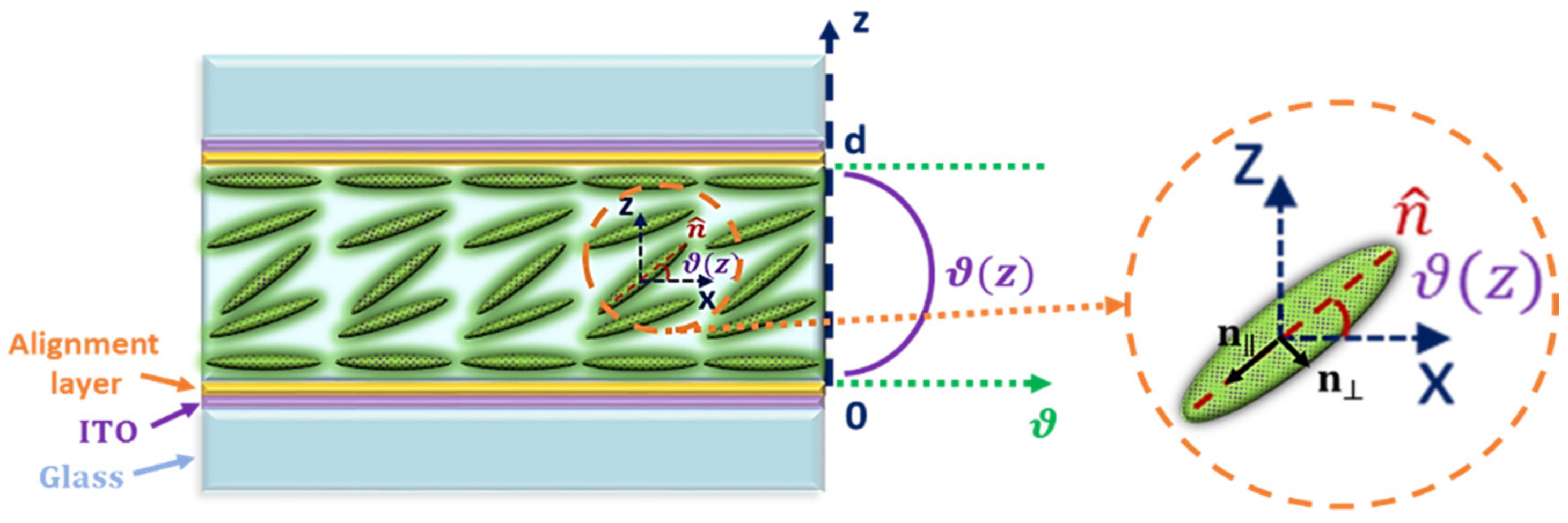

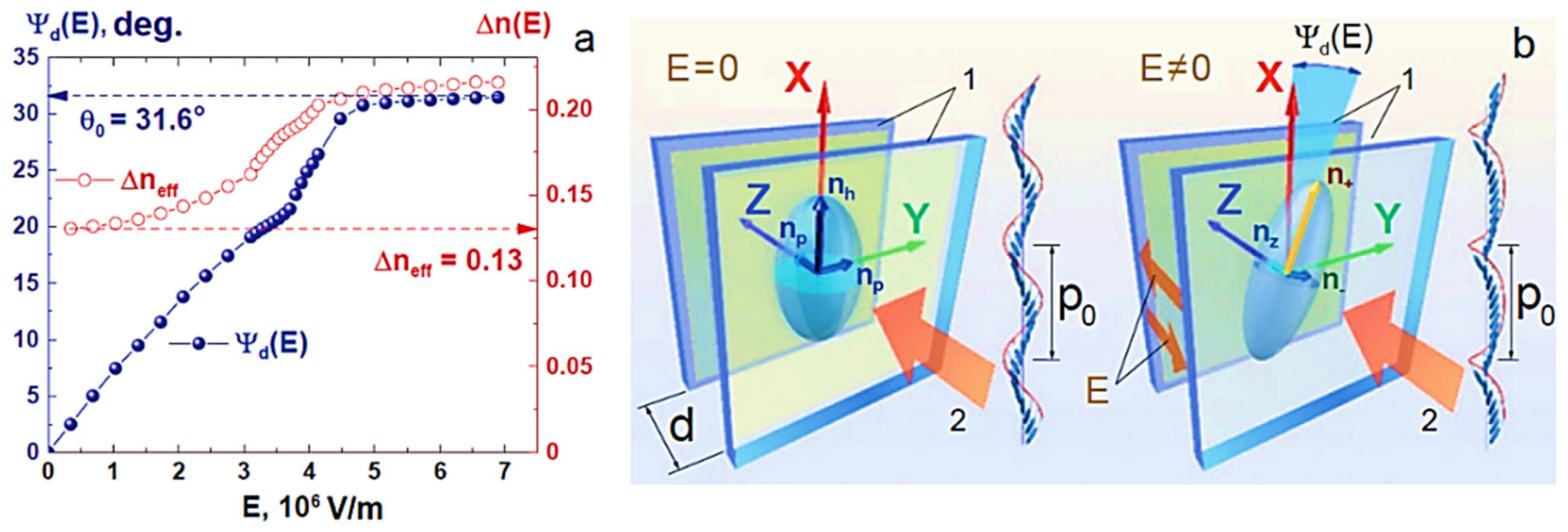
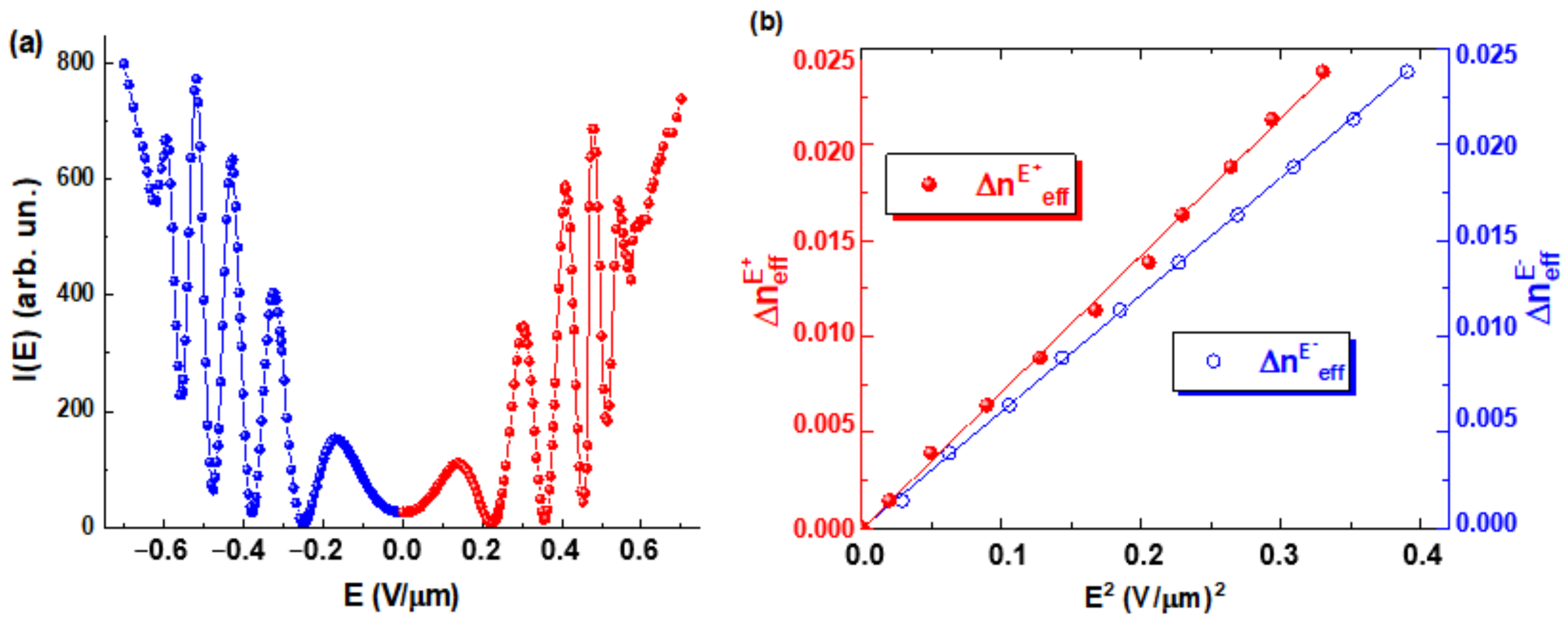


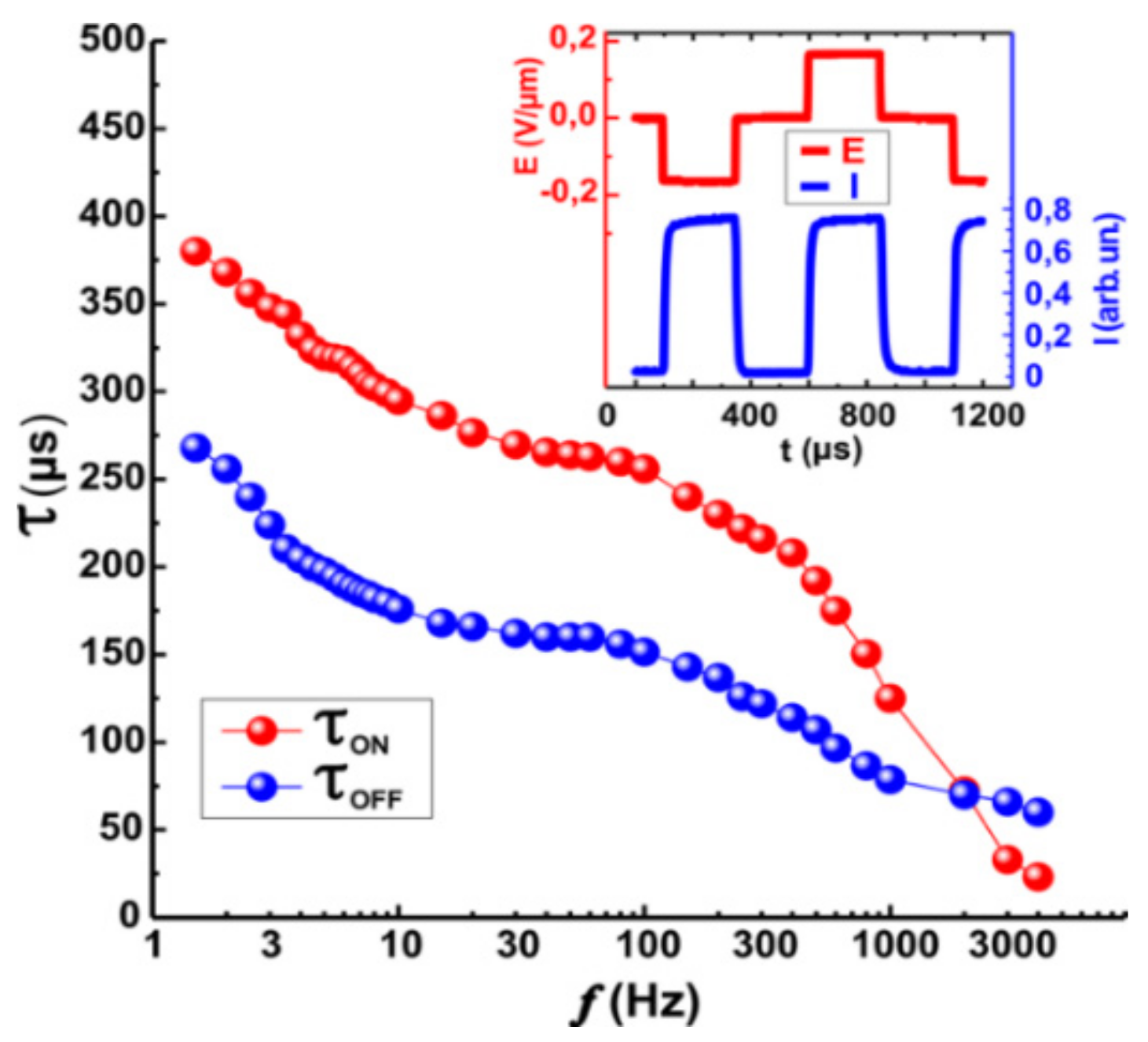
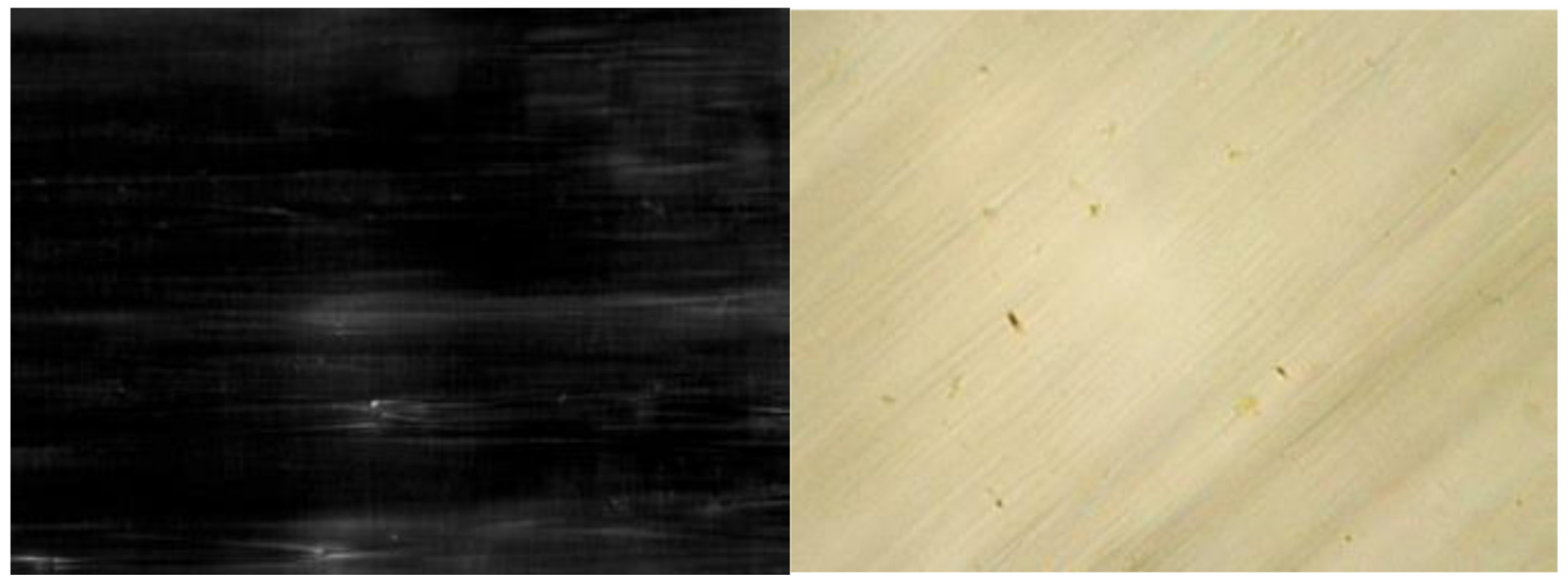
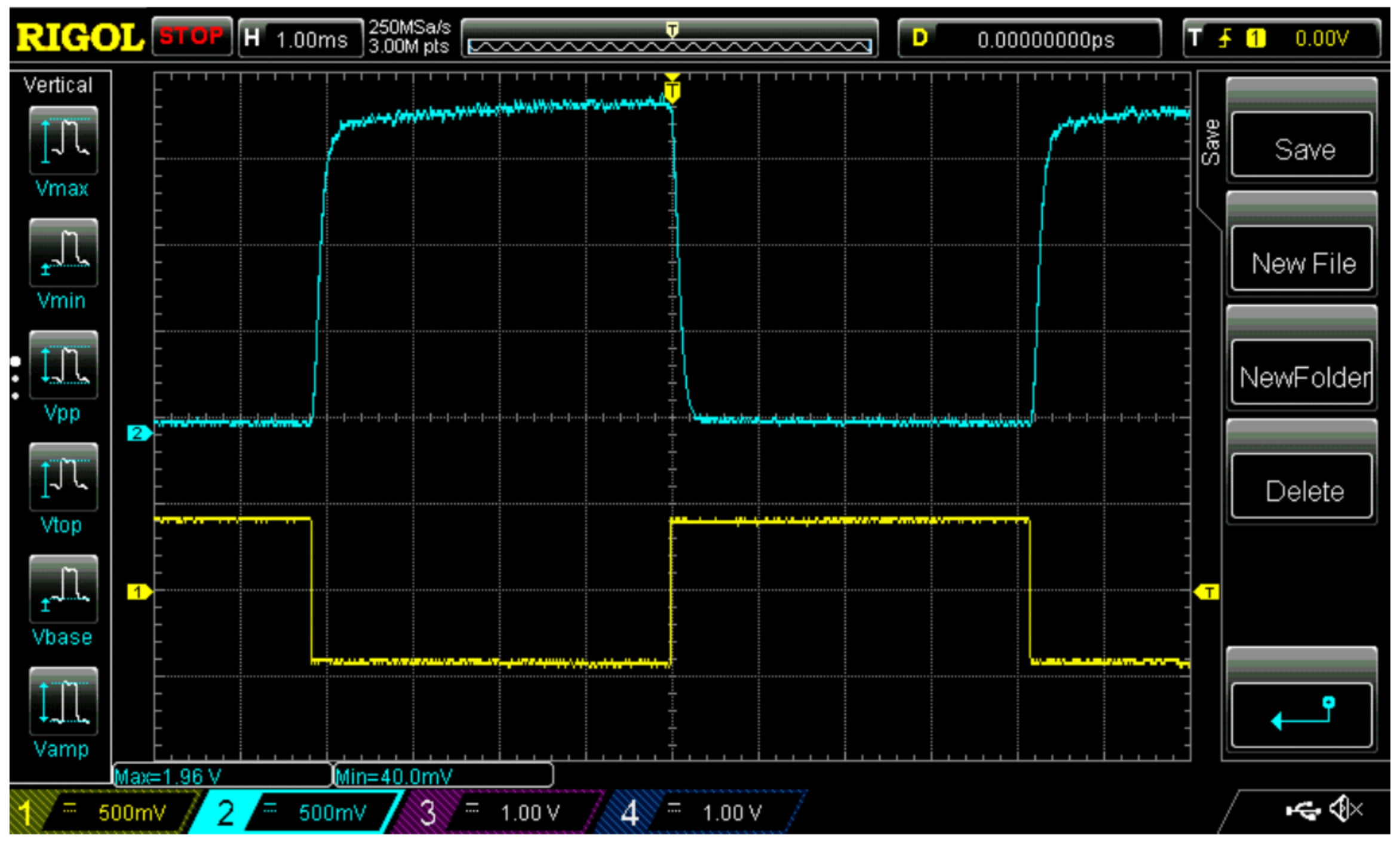
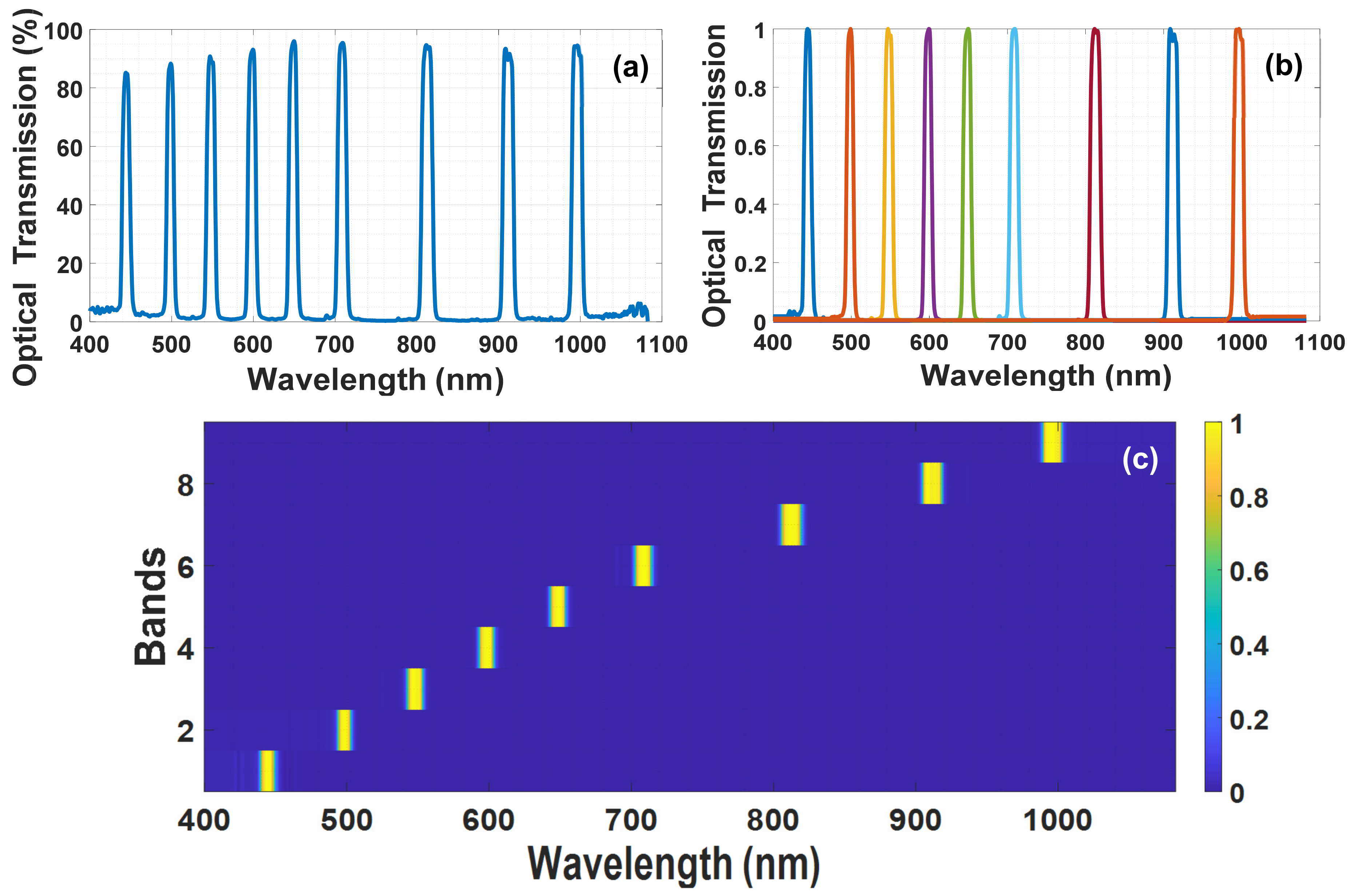
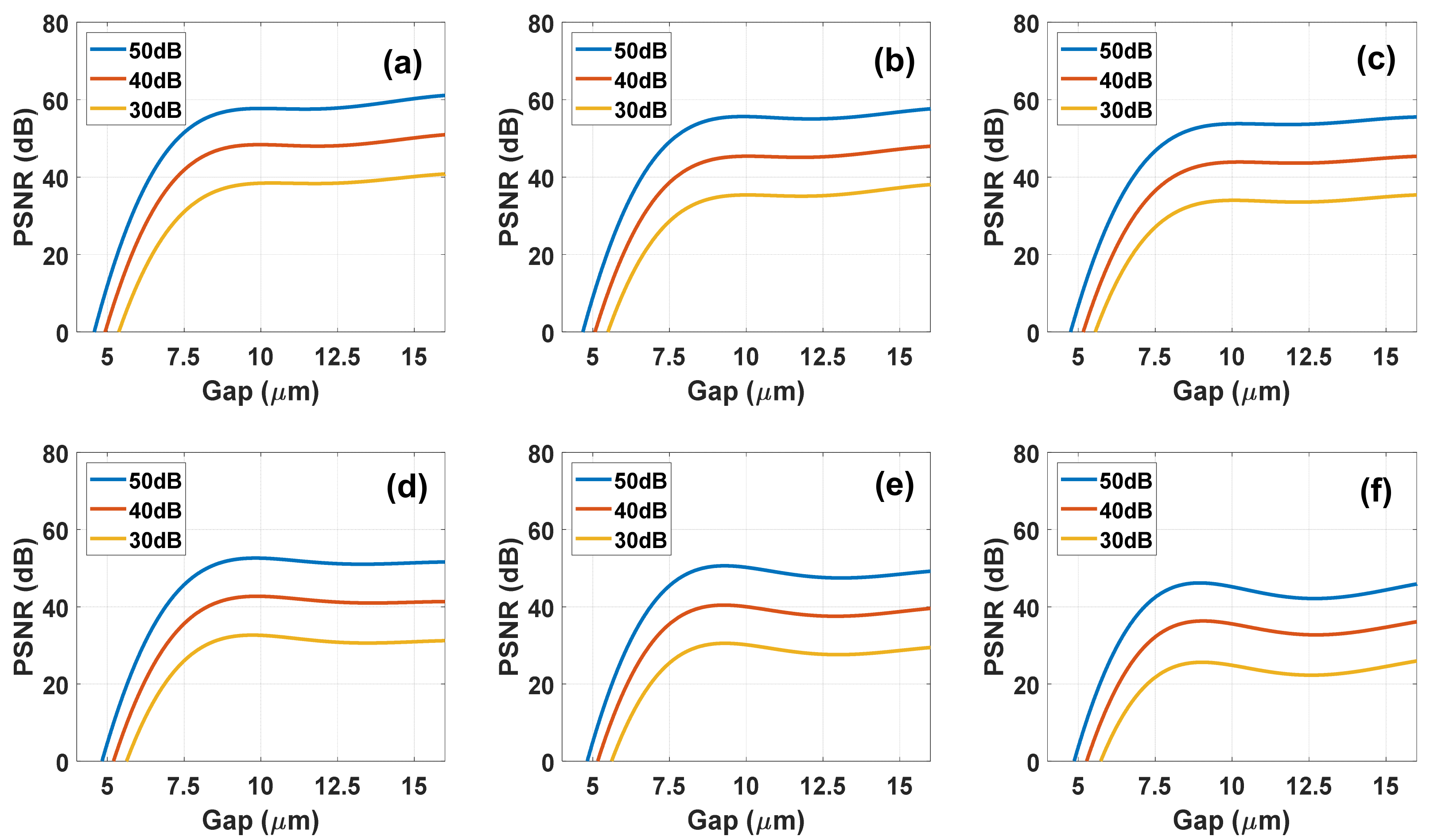



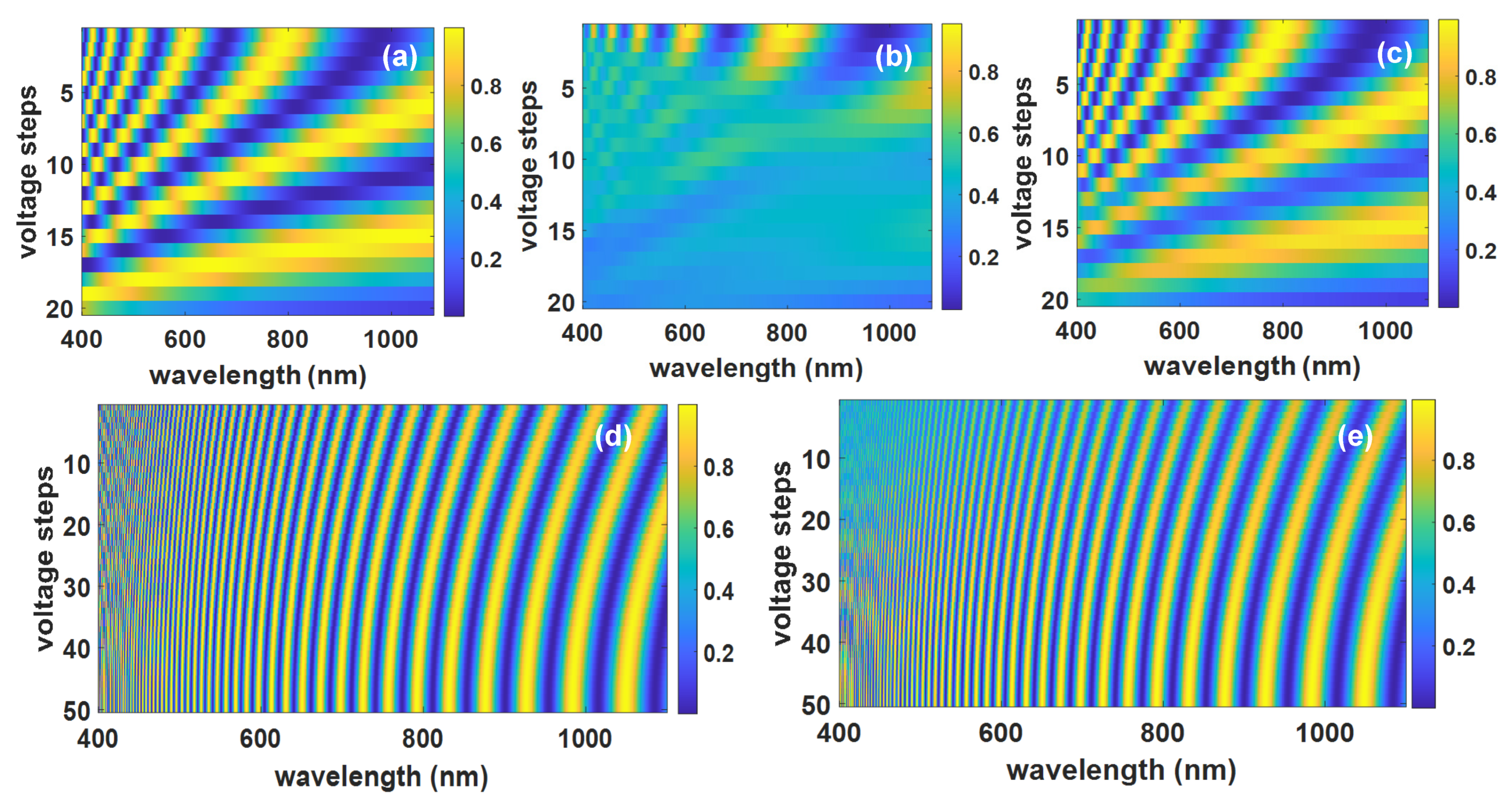
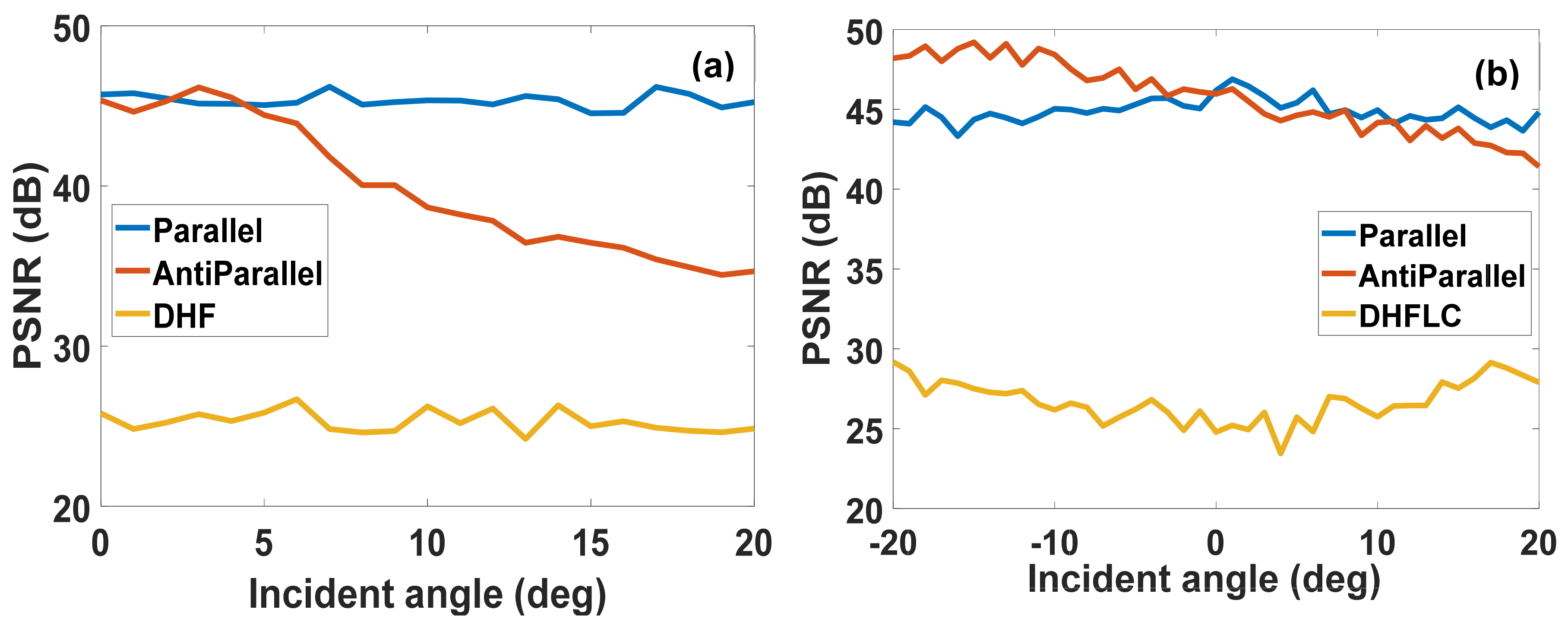
| Application | Spectral Bands Used (nm) | Tuning Methodology | FWHM (nm) | Ref |
|---|---|---|---|---|
| Skin cancer diagnosis | 440, 460, 490, 510, 530, 550, 710, 780, 790 | LCTF | - | [43] |
| Skin chromophores mapping | 700, 750, 750, 800, 850, 1000 | Filter wheel | 40 | [44,45] |
| Skin cancer detection | 500–700 in 10 nm steps | LCTF | 8 | [46] |
| Melanoma and Nevi evaluation | 540, 650, 950 | Passive filters | 15 | [47] |
| Skin cancer detection with smartphone | 450, 470, 500, 530, 580, 660, 810, 940 | LEDs | 20 | [48] |
| Skin hemodynamics | RGB | Camera filters | >60 | [49] |
| Oral cavity detection | 627, 512, 447, 573 | LEDs | 20 | [50] |
| Moldy apple core detection | 425, 455, 515, 615, 660, 700, 850 | Pixelated spectral sensor | - | [51] |
| Minced beef evaluation | 515, 595, 650, 880 | Spectrograph | - | [52] |
| Assessment of fruits and vegetables | Different combinations of wavelengths in the range 435–950 | Commercial instruments | - | [53] |
| Blood glucose measurement | 9259, 10526 | CO2 laser | <1 | [54] |
| Two or three wavelengths pulse oximetry | 805 and other wavelength, 767&811, three wavelengths in the range 760–900 | LEDs | 18 | [55] |
| Retinal oximetry | 570, 600 or the blue-green | Lasers, LEDs | - | [56,57] |
| Remote sensing, spectral LiDAR | 8 wavelengths covering 470 nm–830 nm range | Filters | 10–50 | [58] |
Publisher’s Note: MDPI stays neutral with regard to jurisdictional claims in published maps and institutional affiliations. |
© 2021 by the authors. Licensee MDPI, Basel, Switzerland. This article is an open access article distributed under the terms and conditions of the Creative Commons Attribution (CC BY) license (https://creativecommons.org/licenses/by/4.0/).
Share and Cite
AbuLeil, M.J.; Pasha, D.; August, I.; Pozhidaev, E.P.; Barbashov, V.A.; Tkachenko, T.P.; Kuznetsov, A.V.; Abdulhalim, I. Helical Nanostructures of Ferroelectric Liquid Crystals as Fast Phase Retarders for Spectral Information Extraction Devices: A Comparison with the Nematic Liquid Crystal Phase Retarders. Materials 2021, 14, 5540. https://doi.org/10.3390/ma14195540
AbuLeil MJ, Pasha D, August I, Pozhidaev EP, Barbashov VA, Tkachenko TP, Kuznetsov AV, Abdulhalim I. Helical Nanostructures of Ferroelectric Liquid Crystals as Fast Phase Retarders for Spectral Information Extraction Devices: A Comparison with the Nematic Liquid Crystal Phase Retarders. Materials. 2021; 14(19):5540. https://doi.org/10.3390/ma14195540
Chicago/Turabian StyleAbuLeil, Marwan J., Doron Pasha, Isaac August, Evgeny P. Pozhidaev, Vadim A. Barbashov, Timofey P. Tkachenko, Artemy V. Kuznetsov, and Ibrahim Abdulhalim. 2021. "Helical Nanostructures of Ferroelectric Liquid Crystals as Fast Phase Retarders for Spectral Information Extraction Devices: A Comparison with the Nematic Liquid Crystal Phase Retarders" Materials 14, no. 19: 5540. https://doi.org/10.3390/ma14195540
APA StyleAbuLeil, M. J., Pasha, D., August, I., Pozhidaev, E. P., Barbashov, V. A., Tkachenko, T. P., Kuznetsov, A. V., & Abdulhalim, I. (2021). Helical Nanostructures of Ferroelectric Liquid Crystals as Fast Phase Retarders for Spectral Information Extraction Devices: A Comparison with the Nematic Liquid Crystal Phase Retarders. Materials, 14(19), 5540. https://doi.org/10.3390/ma14195540







